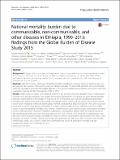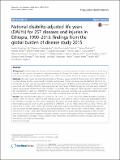National Mortality Burden due to Communicable, Non-communicable, and other Diseases in Ethiopia, 1990-2015_Findings from the Global Burden of Disease Study 2015
View/
Publication Date
2017-07-21views
downloads
Metadata
Show full item recordCitation
Misganaw, A., Haregu, T. N., Deribe, K., Tessema, G. A., Deribew, A., Melaku, Y. A., Amare, A. T., Abera, S. F., Gedefaw, M., Dessalegn, M., Lakew, Y., Bekele, T., Mohammed, M., Yirsaw, B. D., Damtew, S. A., Krohn, K. J., Achoki, T., Blore, J., Assefa, Y., & Naghavi, M. (2017). National mortality burden due to communicable, non-communicable, and other diseases in Ethiopia, 1990-2015: Findings from the Global Burden of Disease Study 2015. Population Health Metrics, 15(1), [29]. https://doi.org/10.1186/s12963-017-0145-1
Abstract/
Background: Ethiopia lacks a complete vital registration system that would assist in measuring disease burden and risk factors. We used the Global Burden of Diseases, Injuries, and Risk Factors Study 2015 (GBD 2015) estimates to describe the mortality burden from communicable, non-communicable, and other diseases in Ethiopia over the last 25 years. Methods: GBD 2015 mainly used cause of death ensemble modeling to measure causes of death by age, sex, and year for 195 countries. We report numbers of deaths and rates of years of life lost (YLL) for communicable, maternal, neonatal, and nutritional (CMNN) disorders, non-communicable diseases (NCDs), and injuries with 95% uncertainty intervals (UI) for Ethiopia from 1990 to 2015. Results: CMNN causes of death have declined by 65% in the last two-and-a-half decades. Injury-related causes of death have also decreased by 70%. Deaths due to NCDs declined by 37% during the same period. Ethiopia showed a faster decline in the burden of four out of the five leading causes of age-standardized premature mortality rates when compared to the overall sub-Saharan African region and the Eastern sub-Saharan African region: lower respiratory infections, tuberculosis, HIV/AIDS, and diarrheal diseases; however, the same could not be said for ischemic heart disease and other NCDs. Non-communicable diseases, together, were the leading causes of age-standardized mortality rates, whereas CMNN diseases were leading causes of premature mortality in 2015. Although lower respiratory infections, tuberculosis, and diarrheal disease were the leading causes of age-standardized death rates, they showed major declines from 1990 to 2015. Neonatal encephalopathy, iron deficiency anemia, protein-energy malnutrition, and preterm birth complications also showed more than a 50% reduction in burden. HIV/AIDS-related deaths have also decreased by 70% since 2005. Ischemic heart disease, hemorrhagic stroke, and ischemic stroke were among the top causes of premature mortality and age standardized death rates in Ethiopia in 2015. Conclusions: Ethiopia has been successful in reducing deaths related to communicable, maternal, neonatal, and nutritional deficiency diseases and injuries by 65%, despite unacceptably high maternal and neonatal mortality rates. However, the country’s performance regarding non-communicable diseases, including cardiovascular disease, diabetes, cancer, and chronic respiratory disease, was minimal, causing these diseases to join the leading causes of premature mortality and death rates in 2015. While the country is progressing toward universal health coverage, prevention and control strategies in Ethiopia should consider the double burden of common infectious diseases and non-communicable diseases: lower respiratory infections, diarrhea, tuberculosis, HIV/AIDS, cardiovascular disease, cancer, and diabetes. Prevention and control strategies should also pay special attention to the leading causes of premature mortality and death rates caused by non-communicable diseases: cardiovascular disease, cancer, and diabetes. Measuring further progress requires a data revolution in generating, managing, analyzing, and using data for decision-making and the creation of a full vital registration system in the country.
Subject/
Causes of death; Mortality; Communicable disease; Non-communicable diseases; Ethiopia; Global burden of disease
Further Details
© The Author(s). 2017 Open Access This article is distributed under the terms of the Creative Commons Attribution 4.0 International License (http://creativecommons.org/licenses/by/4.0/), which permits unrestricted use, distribution, and reproduction in any medium, provided you give appropriate credit to the original author(s) and the source, provide a link to the Creative Commons license, and indicate if changes were made. The Creative Commons Public Domain Dedication waiver (http://creativecommons.org/publicdomain/zero/1.0/) applies to the data made available in this article, unless otherwise stated.
Publisher
Springer NatureISSN
1478-7954Collections
- General - GEN [367]
Related items
Showing items related by title, author, creator and subject.
-
National disability-adjusted life years (DALYs) for 257 diseases and injuries in Ethiopia, 1990–2015: findings from the global burden of disease study 2015
Misganaw, Awoke; Melaku, Yohannes Adama; Tessema, Gizachew Assefa; Deribew, Amare; Deribe, Kebede; Abera, Semaw Ferede; Dessalegn, Muluken; Lakew, Yihunie; Bekele, Tolesa; Haregu, Tilahun N.; Amare, Azmeraw T.; Gedefaw, Molla; Mohammed, Mesoud; Yirsaw, Biruck Desalegn; Damtew, Solomon Abrha; Achoki, Tom; Blore, Jed; Krohn, Kristopher J.; Assefa, Yibeltal; Kifle, Mahlet; Naghav, Mohsen (Population Health Metrics, 2017)Background: Disability-adjusted life years (DALYs) provide a summary measure of health and can be a critical input to guide health systems, investments, and priority-setting in Ethiopia. We aimed to determine the leading ... -
CHP 231: Disease Surveillance
Department of Community Health, Amref International University (Amref International University, 2021-07-30) -
HDCH123: Communicable and Non Communicable diseases
Department of Community Health Practice, Amref International University (Amref International University, 2020-01-19)


